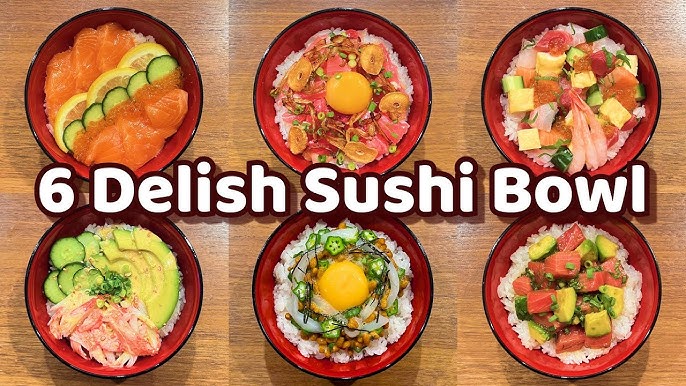Sushi Bowl Recipe: A sushi bowl is a modern and deconstructed twist on traditional sushi rolls. Rather than rolling seaweed, rice, and fillings into bite-sized pieces, all the ingredients are layered in a bowl for a more relaxed, customizable experience. Imagine your favorite sushi roll exploded into a vibrant, colorful bowl bursting with texture and flavor—it’s sushi without the hassle of rolling. It’s casual yet just as satisfying.
These bowls are often known as “chirashi bowls” in Japanese cuisine, where chirashi means “scattered.” The concept is simple: layer vinegared rice with fresh toppings like raw fish, vegetables, sauces, and garnishes. What makes sushi bowls popular is not only the ease of preparation but also the freedom they offer to personalize based on dietary preferences and availability of ingredients.
Sushi bowls have surged in popularity thanks to their Instagram-worthy appearance and the health-conscious, DIY food movement. They offer a balanced mix of carbs, proteins, and fresh vegetables, making them perfect for lunch, dinner, or even meal prepping for the week.
Why Choose a Sushi Bowl Over Traditional Sushi?
Making traditional sushi at home can be quite the task. Between sourcing sushi-grade fish, getting the rice just right, and mastering the art of rolling with nori, it’s not exactly beginner-friendly. That’s where sushi bowls come in.
Here’s why sushi bowls are a game-changer:
- No rolling required: You skip the tedious steps of rolling and slicing.
- More forgiving: No worries about the roll falling apart or the presentation looking sloppy.
- More customizable: You can throw in whatever ingredients you have on hand.
- Faster prep time: Once your rice is ready, assembling a bowl takes minutes.
- Better for groups: Everyone can make their own bowl just how they like it.
Plus, sushi bowls are a great way to introduce sushi to someone who might be wary of raw fish. You can offer cooked options like shrimp, grilled tofu, or teriyaki chicken and still capture the sushi essence.
Essential Ingredients for a Sushi Bowl
Base: Sushi Rice or Alternatives
The base of any good sushi bowl starts with the rice. Traditional sushi rice is made from short-grain Japanese rice that becomes sticky and slightly sweet when seasoned with rice vinegar, sugar, and salt. Here’s how to make it:
- Rinse the rice thoroughly until the water runs clear.
- Cook it using a rice cooker or on the stove.
- While it’s still warm, mix with a seasoning of rice vinegar (1/4 cup), sugar (2 tbsp), and salt (1 tsp) per 2 cups of cooked rice.
But don’t worry if sushi rice isn’t your thing. There are plenty of alternatives:
- Brown rice: Adds more fiber and a nutty flavor.
- Quinoa: A protein-packed substitute for those going gluten-free.
- Cauliflower rice: Perfect for low-carb or keto dieters.
Whatever base you choose, make sure it’s sticky enough to hold together and mild enough to let the toppings shine.
Protein Choices: From Raw to Cooked Options
Protein is where you can really get creative. For a classic sushi flavor, go for raw fish—but make sure it’s sushi-grade. Here are some popular options:
- Raw Fish: Tuna, salmon, yellowtail (opt for sashimi-grade quality).
- Cooked Seafood: Shrimp (boiled or tempura-style), crab meat, seared scallops.
- Non-Seafood: Teriyaki chicken, grilled beef strips, tofu, tempeh.
- Plant-based: Baked tofu, marinated mushrooms, chickpeas, or edamame.
You can even mix two or three proteins in one bowl. Just remember to keep the flavors balanced—don’t let one overpower the rest.
Toppings and Add-Ons for Flavor and Crunch
This is where your sushi bowl goes from “meh” to “wow.” The toppings add texture, color, and flavor contrast. Consider adding:
- Fresh veggies: Cucumber, avocado, carrots, radish, bell peppers.
- Pickled items: Ginger, pickled radish, kimchi.
- Crunchy toppings: Tempura flakes, toasted sesame seeds, crispy onions.
- Seaweed: Nori strips, seaweed salad, or furikake seasoning.
Cut everything into bite-sized pieces so each forkful has a mix of flavor and texture. Think of it like building a salad—but with sushi ingredients.
Sauces and Seasonings to Elevate the Taste
A good sauce can make or break your sushi bowl. Here are some tried-and-true options:
- Soy Sauce: Light or dark, used as a drizzle or dipping option.
- Spicy Mayo: Mix mayo with sriracha for a creamy kick.
- Eel Sauce (Unagi Sauce): Sweet, umami-rich glaze made from soy, sugar, and mirin.
- Ponzu Sauce: A citrusy soy blend that adds zing.
- Wasabi and Pickled Ginger: Classic sushi condiments for heat and cleansing the palate.
Try layering your sauces or offering them on the side. Drizzling your bowl like an artist with a paintbrush adds a visual appeal too.
Kitchen Tools You’ll Need
Basic Equipment
The beauty of sushi bowls is their simplicity—you don’t need a ton of kitchen gear to make one. But having a few essentials on hand will make the process smoother and more enjoyable. Here’s what you’ll want to have ready:
- Rice Cooker or Pot with Lid: A rice cooker is ideal for perfect, fluffy rice every time. If you don’t have one, a sturdy pot with a tight lid will work just fine.
- Mixing Bowl: For tossing your rice with vinegar and seasoning.
- Sharp Knife: Crucial for slicing vegetables and proteins cleanly, especially if you’re working with raw fish.
- Cutting Board: Use separate boards for vegetables and proteins to prevent cross-contamination.
- Small Sauce Bowls or Squeeze Bottles: Great for serving or drizzling your favorite sauces.
You likely already have most of these tools in your kitchen. The goal is ease and efficiency—no sushi mats or complicated tools required.
Optional Tools for Convenience
While not necessary, these tools can level up your sushi bowl game:
- Mandoline Slicer: Ideal for getting paper-thin slices of cucumber, radish, or carrots.
- Avocado Slicer: Makes slicing avocados neater and faster.
- Vegetable Spiralizer: Adds a decorative flair with spiraled veggies.
- Mini Whisk or Fork: Helps blend sauces smoothly.
Optional tools add finesse and presentation quality to your bowl, making them great if you’re planning to impress guests or want to elevate your Instagram food game.
Step-by-Step Instructions for Making a Sushi Bowl
Step 1: Preparing the Sushi Rice
This step lays the foundation for your entire bowl, so don’t rush it. Sushi rice has a specific texture and flavor that sets it apart from regular rice. Here’s how to make it just right:
- Rinse the Rice: Wash the rice under cold water until the water runs almost clear. This removes excess starch, which can make the rice too sticky.
- Cook the Rice: Use a 1:1.1 ratio of rice to water in a rice cooker or pot. Let it steam after cooking for 10 minutes to finish evenly.
- Season the Rice: In a small pan, warm ¼ cup rice vinegar, 2 tbsp sugar, and 1 tsp salt until dissolved. Gently fold into the cooked rice using a wooden spoon. Avoid mashing it—use slicing motions to preserve the grains.
- Cool the Rice: Spread it out in a wide bowl or tray and fan it while mixing to cool it quickly. This adds shine and helps it reach that perfect sushi texture.
Properly prepared sushi rice is slightly tangy, a little sweet, and perfectly sticky—everything you want as your bowl’s base.
Step 2: Selecting and Prepping the Protein
This is your chance to be creative. Whether you’re a sushi purist or someone who’s never eaten raw fish, there’s a protein option for you.
If you’re using raw fish, make sure to:
- Buy sushi-grade fish: This means it’s been frozen to kill parasites and is safe for raw consumption.
- Slice thinly: Cut against the grain into sashimi-like slices or bite-sized chunks.
- Keep it cold: Always refrigerate until just before serving.
For cooked options:
- Shrimp: Boil and chill, or pan-sear for a little char.
- Chicken or Beef: Marinate in teriyaki or soy sauce, then grill or sear.
- Tofu: Press out moisture, cube, and pan-fry until golden. Great with a drizzle of soy sauce or sesame oil.
Consider combining two proteins for variety—maybe grilled shrimp with spicy tuna, or crispy tofu with teriyaki chicken.
Step 3: Cutting and Arranging Vegetables
The vegetables in your sushi bowl bring crunch, color, and freshness. Go for a mix of soft and crisp, raw and pickled. Here are some fan-favorite additions:
- Cucumber: Thinly sliced or julienned for crisp texture.
- Carrots: Shredded or spiralized for sweetness and color.
- Avocado: Creamy and rich—slice or cube it just before serving.
- Radish: Peppery and crunchy, ideal for balancing sweetness.
- Edamame: Packed with protein; use pre-cooked and shelled.
- Seaweed Salad: Brings an umami kick and chewy texture.
Presentation matters. Think in terms of color balance and texture layering. Place ingredients in neat sections for that restaurant-quality look. It’s like painting your bowl with food!
Step 4: Assembling the Bowl
Now the fun part—putting it all together. Start by scooping about a cup of sushi rice into a deep bowl. Then, arrange your chosen ingredients in small piles or fan shapes around the bowl’s edge, leaving the center open for the protein or sauce.
Here’s a simple method:
- Base: Lay the sushi rice down evenly.
- Veggies: Add each veggie in its section.
- Protein: Place your fish, shrimp, or tofu prominently in the middle or across the top.
- Crunchy Toppings: Sprinkle sesame seeds, crushed nori, or tempura flakes.
- Sauce: Drizzle or zig-zag your sauces across the top, or serve on the side.
Make it visually appealing. This isn’t just a meal—it’s a whole aesthetic.
Step 5: Adding Sauces and Garnishes
Your sushi bowl isn’t complete without the finishing touches. Sauces amplify flavors and tie everything together. Mix and match depending on your taste:
- Spicy Mayo: Blend 1 tbsp mayo with 1 tsp sriracha for a creamy heat.
- Soy Sauce: A splash of low-sodium soy sauce adds umami depth.
- Ponzu: A light, citrusy soy alternative.
- Eel Sauce: Sweet and savory, great on raw or cooked fish.
- Wasabi & Pickled Ginger: Use sparingly; they’re strong!
Top it off with:
- Scallions: Thinly sliced green onions for color and zest.
- Toasted Sesame Seeds: Nutty and aromatic.
- Nori Strips: For that authentic sushi flavor.
- Microgreens or Sprouts: Optional, but Instagram-worthy.
Tips for Customizing Your Sushi Bowl
Vegan and Vegetarian Options
If you’re plant-based or just looking to skip animal products, sushi bowls are a dream come true. They’re endlessly flexible, and you can pack them with flavor and nutrients without using meat or seafood.
Here’s how to build an epic vegan sushi bowl:
Base: Start with your rice (white, brown, or cauliflower). You can even mix in quinoa or bulgur for texture and protein.
Protein:
- Tofu: Press and pan-fry until golden brown. Marinate in soy sauce, garlic, and sesame oil for added punch.
- Tempeh: Nutty and dense, it’s a great meat substitute. Slice and sear with teriyaki sauce.
- Chickpeas: Roasted or seasoned with a bit of wasabi powder.
- Edamame: High in protein and naturally delicious.
Veggies: Load up with colorful and crisp vegetables—shredded cabbage, carrots, sweet corn, avocado, pickled beets, cucumber, and radish.
Toppings:
- Seaweed salad: Packed with umami and minerals.
- Crushed peanuts or cashews for crunch.
- Crispy tofu skin: Like veggie bacon bits.
Sauces:
- Spicy vegan mayo (vegan mayo + sriracha).
- Soy-ginger dressing.
- Tahini miso sauce.
This version can be just as indulgent and beautiful as any traditional sushi bowl—plus, it’s easier to store for meal prep and super nutritious.
Low-Carb and Gluten-Free Versions
Trying to keep carbs in check? Or avoiding gluten? No problem—sushi bowls are incredibly adaptable for different diets.
Low-Carb Alternatives:
- Cauliflower rice: Pulse raw cauliflower in a food processor and lightly steam or sauté.
- Zoodles: Spiralized zucchini can be used as a base or topping.
- Shirataki rice: Also known as konjac rice—very low in calories and carbs.
Gluten-Free Tips:
- Use tamari instead of soy sauce—it’s gluten-free and tastes similar.
- Watch out for sauces like eel sauce or store-bought dressings that may contain wheat.
- Use gluten-free vinegar and seasonings.
- Stick to whole, fresh ingredients and double-check any processed toppings.
Sushi bowls don’t have to be rigid. They’re one of the most inclusive meals out there—ready to fit whatever your body and lifestyle need.
FAQs about Sushi Bowl Recipe
Q1: What is a sushi bowl?
A sushi bowl is a deconstructed version of traditional sushi rolls. Instead of being wrapped in seaweed, all the ingredients—sushi rice, fish, vegetables, and sauces—are layered in a bowl for easy serving and enjoyment.
Q2: Can I make a sushi bowl without raw fish?
Absolutely! You can use cooked shrimp, crab meat, grilled salmon, tofu, or even plant-based options like marinated mushrooms or jackfruit for a delicious sushi bowl without raw fish.
Q3: What kind of rice is best for a sushi bowl?
Short-grain Japanese rice or sushi rice is ideal. It has the right sticky texture and can easily absorb the tangy-sweet sushi vinegar dressing.
Q4: Are sushi bowls healthy?
Yes, sushi bowls can be very healthy. They are customizable and can include lean proteins, fresh vegetables, and healthy fats like avocado. Choose low-sodium soy sauce and limit added sugars for an even healthier version.
Q5: Can I prepare sushi bowls ahead of time?
You can prep the ingredients ahead of time and assemble the bowl just before serving. However, it’s best to keep wet ingredients like avocado and sauces separate until ready to eat.
Q6: How do I store leftovers?
Store leftover sushi bowl ingredients in separate airtight containers in the refrigerator. Consume within 1–2 days for best freshness and flavor.
Conclusion
Sushi bowls are the ultimate fusion of flavor, texture, and convenience. They deliver all the satisfaction of a sushi roll without the complexity, making them perfect for beginners and seasoned cooks alike. Whether you’re in the mood for a quick lunch, prepping meals for the week, or planning a fun build-your-own sushi bowl night with friends, these bowls never disappoint.
With endless combinations of bases, proteins, veggies, and sauces, the sushi bowl is like the DIY salad of Japanese cuisine—only cooler and more crave-worthy. You can keep it traditional with raw tuna and nori or go bold with spicy tofu and pickled ginger. There are no rules—just flavor.
So the next time you’re staring into your fridge wondering what to make, remember: if you’ve got rice, some protein, and a few toppings, you’ve got the makings of a sushi bowl that’s fresh, healthy, and totally delicious.



